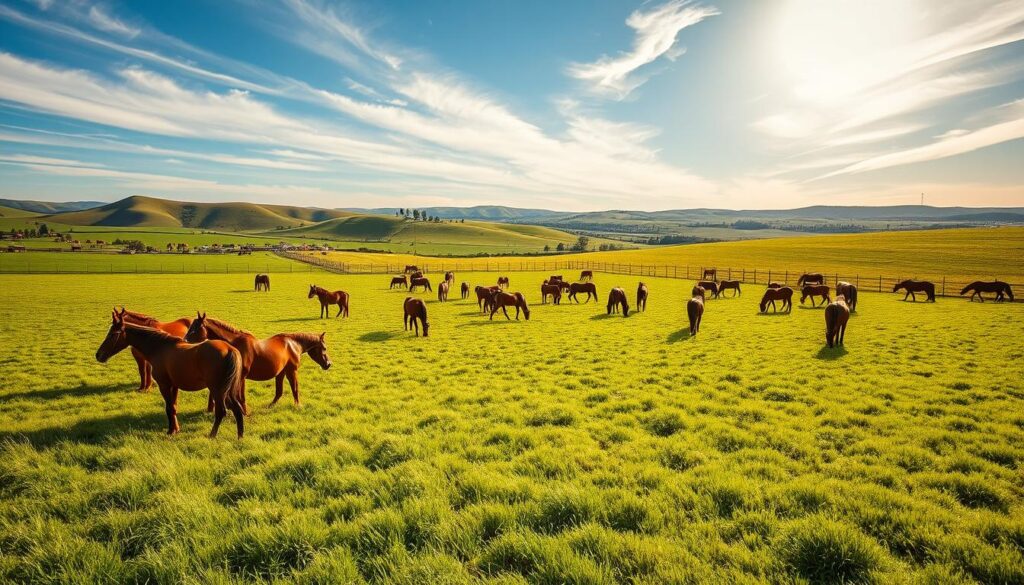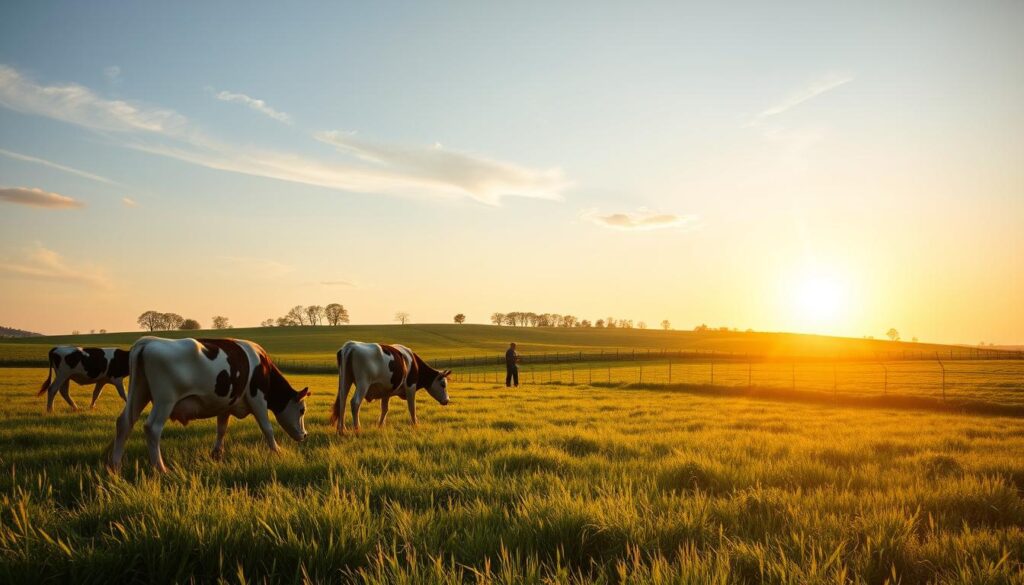Did you know horses naturally spend 12–16 hours daily grazing? A recent University of Guelph study found that consistent pasture access reduces colic risks by 35% while boosting hoof strength and mental well-being. This isn’t just about animal care—thoughtful land use creates ripple effects for ecosystems and farm budgets alike.
Healthy grazing areas do more than provide exercise space. They act as living systems, recycling nutrients and fostering diverse plant life. When managed well, these zones become self-sustaining sources of nutrition, cutting feed costs and supporting soil structure. Rotational techniques prevent overgrazing, letting vegetation recover while maintaining year-round ground cover.
Spring rains test any paddock’s resilience. Strategic overseeding with hardy grass varieties helps combat erosion during wet seasons. Natural amendments like compost tea can revive tired soils without harsh chemicals—a trick many Canadian equine facilities now swear by. The result? Lush growth that withstands hoof traffic and weather extremes.
Key Takeaways
- Daily pasture access significantly lowers digestive issues in horses
- Rotational grazing preserves grass quality and soil integrity
- Natural soil treatments boost paddock productivity sustainably
- Proper land care reduces supplemental feed expenses by up to 30%
- Seasonal overseeding maintains ground cover during heavy rainfall
Understanding the Benefits of Grass Paddocks
Horses thrive when their diet mirrors natural foraging patterns. Well-designed grazing zones serve dual purposes: fueling animals while nurturing ecosystems. The secret lies in balancing plant diversity with strategic land care.
Key Nutritional and Health Advantages
Quality pastures deliver essential nutrients through fresh growth. Perennial ryegrass stands out for its high protein content and resilience across seasons. This species provides steady energy for horses while supporting healthy digestion through natural fiber.
Native plants like timothy and fescue add variety to equine diets. Their mixed growth patterns create a buffet effect, letting livestock self-select nutrients. Studies show diverse grasslands improve gut bacteria balance, reducing colic risks.
Environmental and Soil Health Benefits
Healthy grazing areas act as living filters. Deep root systems prevent topsoil loss during spring rains, while organic matter feeds earthworms and microbes. Regular soil tests help maintain ideal pH levels without synthetic additives.
Smart seeding practices make pastures self-renewing. Adding clover to grass mixes naturally boosts nitrogen levels, cutting fertilizer needs. This approach keeps water sources cleaner and supports carbon storage in grassland ecosystems.
Optimizing Pasture Management for Equine Health
Managing horse pastures effectively requires balancing animal needs with land stewardship. Smart rotation systems and consistent cleanup routines keep both livestock and landscapes thriving.

Effective Paddock Rotation Strategies
Dividing grazing areas into smaller sections lets grasses recover while horses feed elsewhere. A 3-zone rotation works well for most Canadian farms: animals graze one zone for 7–10 days while others regrow. This approach maintains steady forage production and prevents soil compaction.
| Rotation Type | Rest Period | Group Size |
|---|---|---|
| Basic 3-Zone | 21–30 days | 2–4 horses |
| MIG System | 40–60 days | 6–8 horses |
| Strip Grazing | Daily moves | Individual |
Management-intensive grazing (MIG) extends rest periods for deeper root development. Alberta equine specialists recommend weekly pasture checks to adjust rotation timing based on grass height and weather patterns.
Maintaining a Clean and Safe Pasture Environment
Daily manure removal cuts parasite risks by 90% according to Ontario Veterinary College data. Harrowing dry paddocks breaks up waste clusters, while rolling damp areas prevents uneven terrain.
Spring thaw brings unique challenges. Pro tip: Schedule major cleanups after snowmelt but before new growth emerges. This timing disrupts parasite lifecycles while letting sunshine disinfect the soil naturally.
Enhancing Grass and Forage Growth
Healthy soil forms the foundation of productive grazing areas. Strategic techniques revitalize tired fields while preventing invasive species from stealing nutrients. Let’s explore methods that boost plant vitality and sustain year-round forage production.
Overseeding and Weed Control Techniques
Introducing hardy grass varieties like timothy or meadow fescue strengthens existing pastures. Spread seeds during early spring thaw for optimal germination. Pro tip: Mix clover into seed blends to naturally fix nitrogen in soil. This cuts fertilizer needs while adding protein-rich forage options.
Manual weed removal works best for small infestations. Dig ragwort roots completely to prevent regrowth. For larger areas, targeted herbicide applications by licensed contractors protect desirable plants. Always remove weeds before they flower to stop seed dispersal.
Fertilization and Natural Soil Amendments
Soil tests reveal pH imbalances and nutrient gaps. Amend acidic soils with crushed limestone, or add sulfur to alkaline earth. Composted manure delivers slow-release nutrients without chemical runoff risks. Spread it thinly before rains to help absorption.
Harrowing breaks up compacted dirt, letting oxygen reach grass roots. Follow with rolling to smooth surfaces and improve seed-to-soil contact. These steps create resilient turf that withstands hoof traffic and winter frost heave.
Implementing Rotational Grazing: benefits of grass paddocks
Picture this: wild bison herds instinctively roaming fresh plains daily. Management-intensive grazing (MIG) recreates this natural rhythm through planned livestock movement. Unlike continuous grazing where animals linger in one area, MIG shifts herds between smaller sections to let plants recover fully.
How MIG Transforms Land Use
Dividing fields into 8–12 temporary paddocks creates a grazing conveyor belt. Horses eat each section for 1–3 days before moving onward. This approach ensures even forage consumption while allowing 40–60 day rest periods for regrowth. Manitoba ranchers report 25% higher protein content in grasses managed this way.
“MIG turns pastures into solar panels – the more they recover, the more energy they capture.”
| Method | Stocking Rate | Rotation Speed | Forage Yield |
|---|---|---|---|
| Continuous | 2 acres/horse | None | 1.8 tons/acre |
| Basic Rotation | 1.5 acres/horse | Weekly | 2.4 tons/acre |
| MIG System | 1 acre/horse | Daily | 3.1 tons/acre |
Frequent moves break parasite cycles naturally – larvae die before horses return. Soil benefits too: Ontario trials show MIG fields absorb 60% more rainwater, reducing erosion. Adding clover to seed mixes boosts nitrogen levels, cutting fertilizer needs by half.
Start small with 4–6 paddocks. Use portable electric fencing to test rotation timing. Track grass height – move livestock when plants reach 6–8 inches, returning after 3″ regrowth. This rhythm builds resilient pastures that thrive through Canadian winters.
Utilizing Equipment and Techniques for Paddock Maintenance
Modern paddock care blends horsepower with cutting-edge tools. Choosing the right gear keeps fields lush while saving time and effort. Let’s explore solutions that work for both sprawling ranches and backyard setups.
Selecting the Right Mower and Topper Machinery
The Spearhead Multicut rotary mower shines for heavy-duty work. Its adjustable cutting height (2-6 inches) preserves perennial ryegrass while trimming weeds. For finer finishes, MAJOR Flex Wing Toppers deliver 12-foot swaths in a single pass – ideal for preparing seedbeds.
Blade sharpness matters more than you’d think. Dull edges tear plants, inviting disease. Ontario equine centers report 40% faster regrowth when using razor-sharp cutters weekly.
Integrating Technology into Pasture Care
Soil moisture sensors take the guesswork out of irrigation. Pair them with automated water systems to maintain ideal conditions for clover mixes. GPS-guided mowers create precise cutting patterns, reducing fuel use by 25%.
“Smart fencing” apps alert you when livestock wander into rested zones. These tools help maintain rotational schedules without constant field checks.
DIY Tips for Small-Scale Maintenance
Hand-held seed spreaders revive patchy areas between mows. Mix white clover with cool-season grasses for winter-hardy coverage. A simple drag harrow – towed behind an ATV – levels ground and spreads manure naturally.
Weekly walkthroughs spot early issues. Check for compacted soil near water troughs, and reseed bare spots before weeds take hold. These habits keep small pastures productive without big machinery costs.
Seasonal Considerations in Pasture Management
As maple leaves signal autumn’s approach, savvy caretakers tweak their land strategies. Weather shifts demand tailored approaches to keep fields productive year-round. Let’s explore how to work with nature’s calendar while protecting your investment.

Spring Renewal and Winter Prep
Spring demands proactive measures. Begin with topping fields at 4-6 inches to stimulate fresh growth. This removes dead material while letting sunlight reach new shoots. Manitoba equine centers report 20% faster regrowth when combining this with early-season seeding.
| Season | Focus Area | Key Actions | Tools |
|---|---|---|---|
| Spring | Soil Recovery | Overseed clover mixes, test pH levels | Broadcast spreader, soil probe |
| Winter | Moisture Control | Install drainage channels, limit hoof traffic | Geotextile fabric, gravel |
Winter brings unique challenges. Frozen ground needs protection – rotate livestock through sacrifice areas to prevent compaction. Alberta ranchers use temporary fencing to create “rest zones” during heavy snowfall.
Sustainable Cost Strategies
Smart planning cuts expenses while boosting output. Implement a 5-year rotation plan for major reseeding projects. This spreads costs while maintaining forage quality. Clover planting reduces fertilizer bills by fixing nitrogen naturally.
Track grass growth rates to adjust stocking numbers. A simple rule: 1 horse per 2 acres during peak season, 1 per 3 acres in slower months. This prevents overgrazing and keeps vet bills low.
“Aligning grazing systems with seasonal patterns isn’t just practical – it’s how we honor the land’s natural rhythms.”
Conclusion
Creating thriving equine spaces requires both care and smart strategy. Rotational systems keep fields productive while protecting soil structure. Strategic seeding with hardy varieties combats erosion and weeds, ensuring consistent nutrition for livestock.
Advanced equipment like GPS-guided mowers maintains turf quality efficiently. Seasonal adjustments – from winter drainage prep to spring overseeding – prevent costly repairs. These methods reduce feed expenses by 30% while nurturing root networks that filter water naturally.
Smart stocking rates and timed grazing cycles let pastures recover fully. This approach boosts biodiversity, creating environments where beneficial plants outcompete invasive species. Healthy fields become self-sustaining assets that withstand harsh Canadian winters.
Start small: test portable fencing for rotation or try clover mixes in worn areas. Consistent management builds resilient landscapes where horses and nature thrive together. Your efforts today shape tomorrow’s greener, more productive equine spaces.

